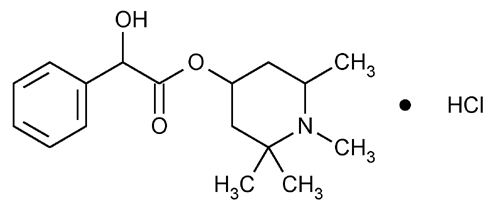Delete the following:
Benzeneacetic acid,
1,2,2,6-Tetramethyl-4-piperidyl mandelate hydrochloride
» Eucatropine Hydrochloride contains not less than 99.0 percent and not more than 100.5 percent of C17H25NO3·HCl, calculated on the dried basis.
Packaging and storage—
Preserve in tight, light-resistant containers.
Identification—
A:
Dissolve about 50 mg in 5 mL of water, render the solution alkaline with 6 N ammonium hydroxide, and extract with two 10-mL portions of ether. Evaporate the ether on a steam bath, and recrystallize the residue from solvent hexane: the eucatropine base so obtained melts between 111 and 114
and 114 .
.
B:
A solution of it responds to the tests for Chloride  191
191 .
.
Loss on drying  731
731 —
Dry it over silica gel for 4 hours: it loses not more than 0.5% of its weight.
—
Dry it over silica gel for 4 hours: it loses not more than 0.5% of its weight.
Residue on ignition  281
281 :
not more than 0.1%.
:
not more than 0.1%.
Assay—
Weigh accurately about 500 mg of Eucatropine Hydrochloride, and dissolve it in 10 mL of water. Saturate the solution with sodium chloride. Render it alkaline with 6 N ammonium hydroxide, and extract the base completely with successive 15-mL portions of ether. Wash the combined ether extracts with 10 mL of water, and extract the water washing with 10 mL of ether. To the combined ether solutions add 25.0 mL of 0.1 N sulfuric acid VS, and stir. Heat gently until the ether is expelled, cool, add methyl red TS, and titrate the excess acid with 0.1 N sodium hydroxide VS. Each mL of 0.1 N sulfuric acid is equivalent to 32.79 mg of C17H25NO3·HCl. USP32
USP32
Auxiliary Information—
Please check for your question in the FAQs before contacting USP.
| Topic/Question | Contact | Expert Committee |
| Monograph | Feiwen Mao, M.S.
Scientist 1-301-816-8320 |
(MDOOD05) Monograph Development-Ophthalmics Oncologics and Dermatologicals |
USP32–NF27 Page 2341
Pharmacopeial Forum: Volume No. 33(6) Page 1168
